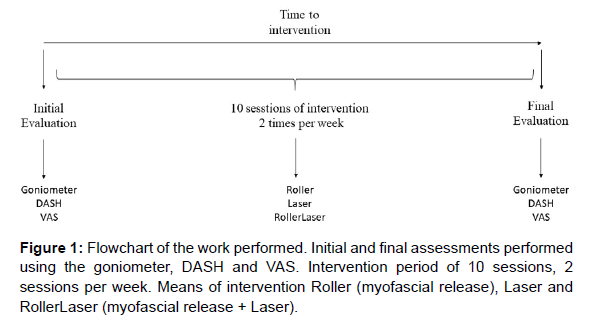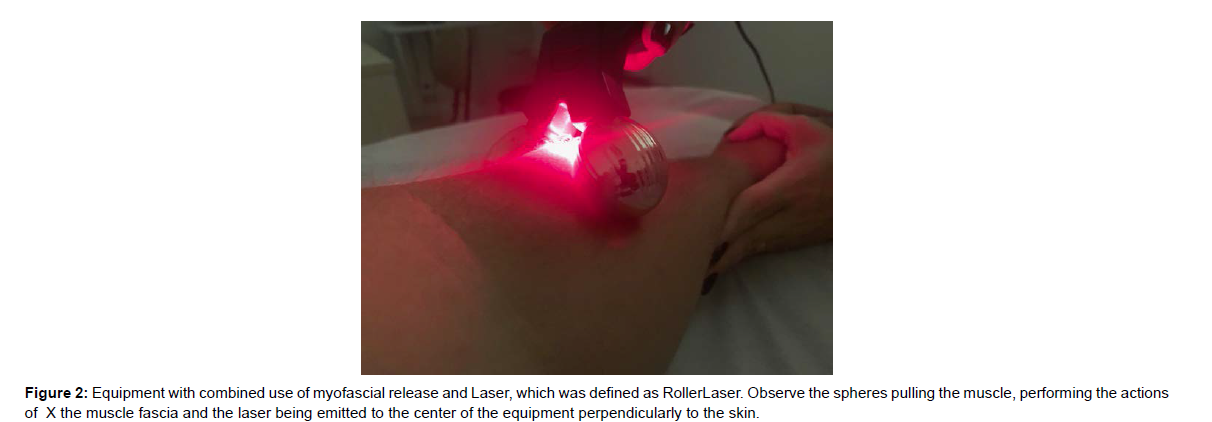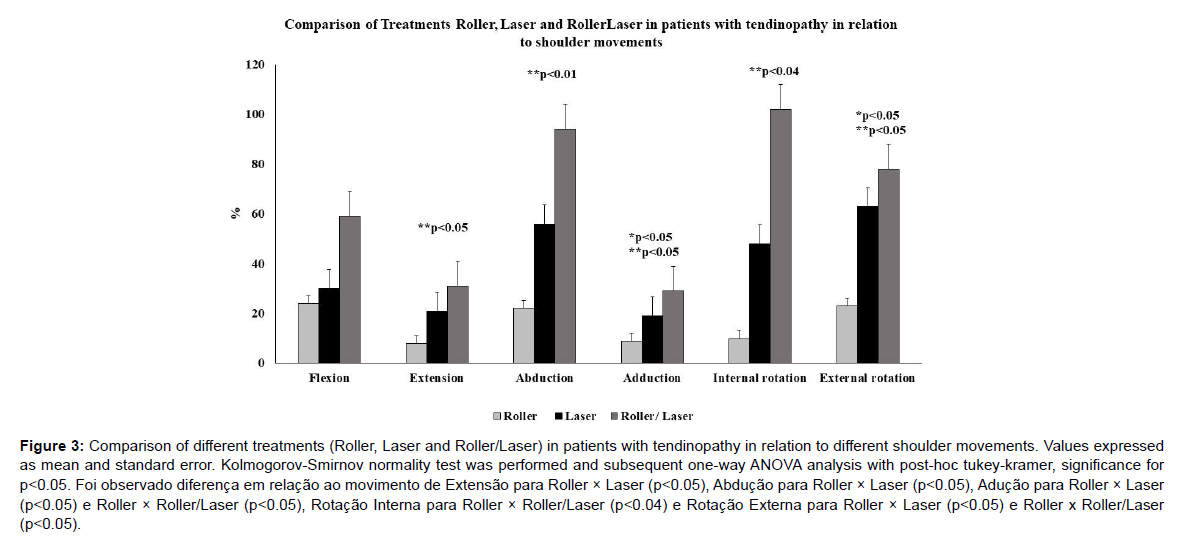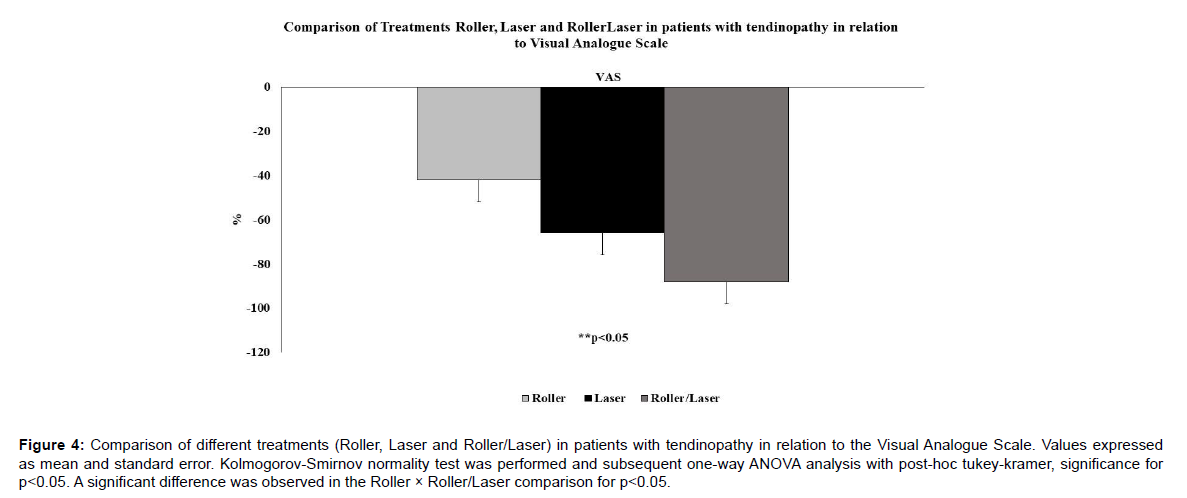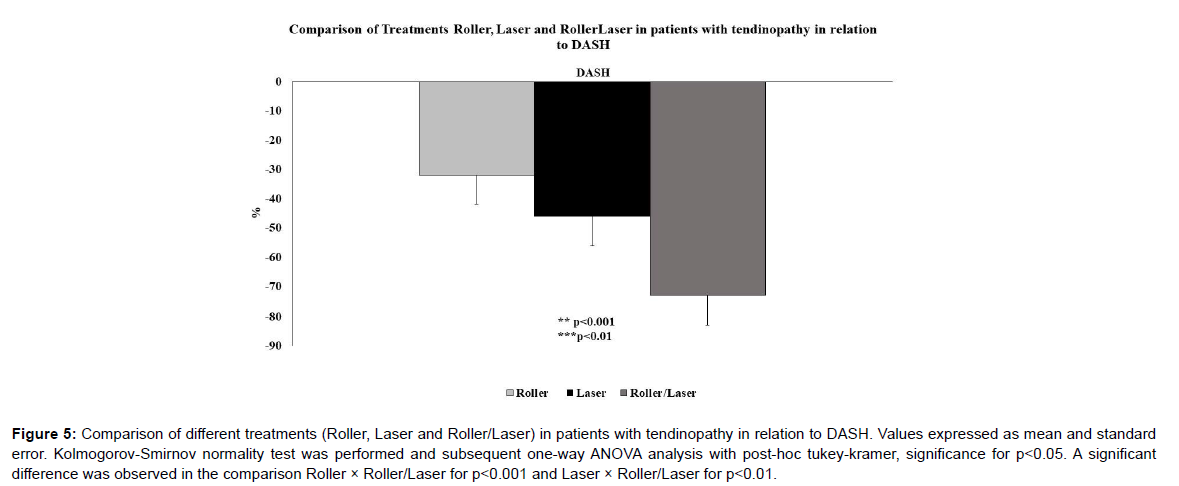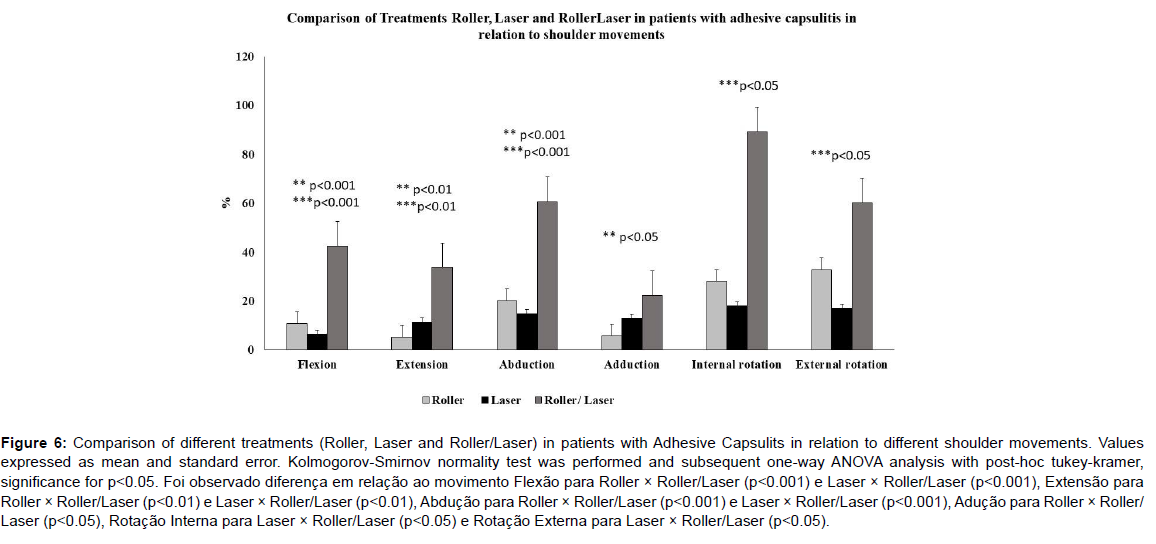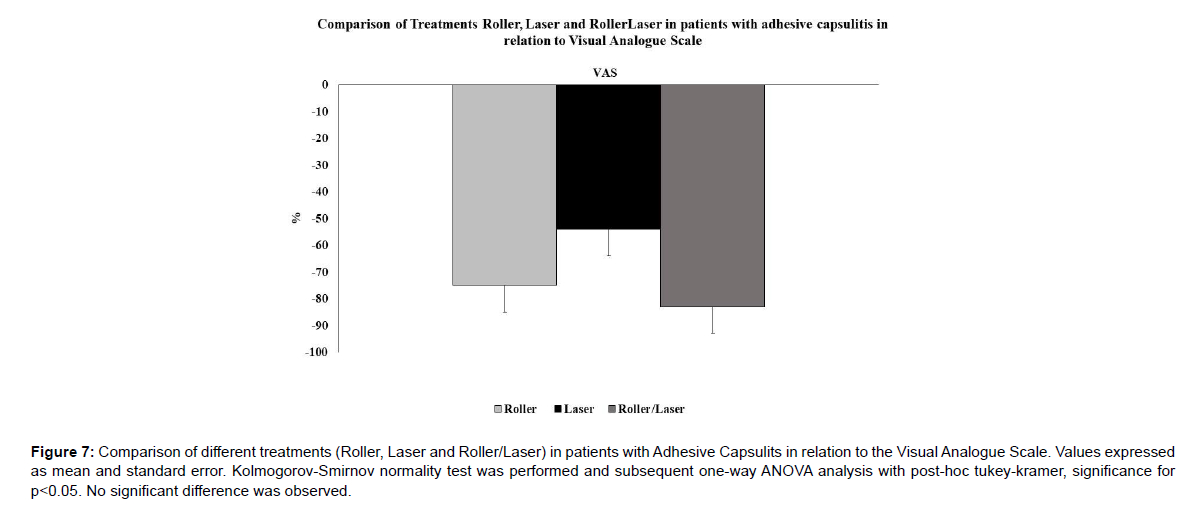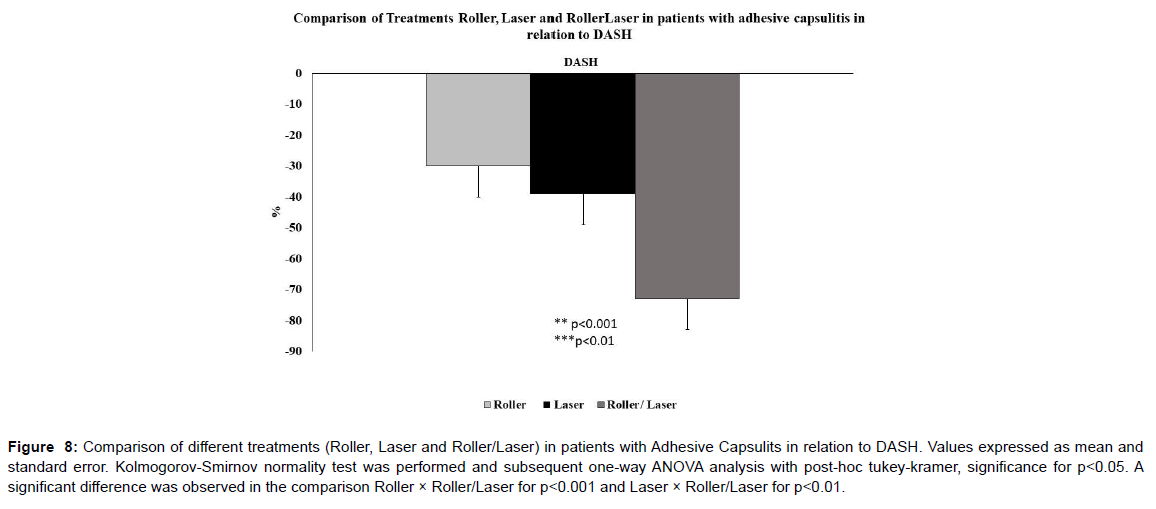Can a New Synergistic Proposal Involving Photobiomodulation and Myofascial Release Accelerate the Evolution of Adhesive Capsulitis and Tendinopathies?
Received: 19-Jul-2022 / Manuscript No. jnp-22-70743 / Editor assigned: 21-Jul-2022 / PreQC No. jnp-22-70743 (PQ) / Reviewed: 04-Aug-2022 / QC No. jnp-22-70743 / Revised: 10-Aug-2022 / Manuscript No. jnp-22-70743 (R) / Accepted Date: 16-Aug-2022 / Published Date: 17-Aug-2022 DOI: 10.4172/2165-7025.1000535
Abstract
The composition of the shoulder, in its complexity, supports bones, muscles and ligaments, both inside and outside the joint capsule, and its range of motion promotes a large number of pathologies, among which are tendinopathy and adhesive capsulitis, conditions that cause pain, inflammation and restriction of movement. Physiotherapy, as a nonpharmacological treatment choice, aims to improve pain control and the inflammatory response. Among the resources used are myofascial release and photobiomodulation. The combined use of these resources was used in injuries, by promoting the overlap of the areas of action of the two resources. The study selected 18 patients with adhesive capsulitis and 18 patients with tendinopathy, aged between 30 and 70 years and randomly divided into 3 subgroups of 6 patients,who underwent myofascial release, photobiomodulation intervention and myofascial release + photobiomodulation.There were 10 treatment sessions with equipment that promotes myofascial release and photobiomodulation with 660nm laser, 30 min each session. As a form of evaluation, goniometry, the visual analogue scale, and the Arm,Shoulder and Hand Dysfunction Questionnaire were used. Significant improvements were observed in the use of the ombined action of myofascial release and photobiomodulation for both pathologies. Thus, the use of this innovative quipment that combines hotobiomodulation and myofascial release, results in a faster therapeutic response for the treatment of various pathologies in the shoulder, returning total or partial mobility of the limb in a reduced treatment time,directly reflecting on the quality of lives.
Keywords
Adhesive capsulitis; Tendinopathy; Myofascial release; Photobiomodulation
Introduction
The tetra articular composition of the shoulder, in its complexity, supports bones, muscles and ligaments, both inside and outside the joint capsule [1]. In this way, the range of movements, as well as their amplitudes, promotes a large number of pathologies [1]. Among the pathologies are tendinopathy and adhesive capsulitis, conditions that cause pain, inflammation and restriction of movement.
Shoulder tendinopathy has a prevalence of 29%, where several studies indicate that these lesions mainly affect women, between the fourth and fifth decades of life and continue to grow from the age of 70, where they present more common symptoms such as pain, inflammation, reduced joint mobility and degeneration of the rotator cuff tendons [2,3]. Tendinopathy is a condition attributed to mechanical and vascular factors, where mechanical factors are predominant due to repetitive strain, trauma and excessive use of the joint, which can generate inflammation and injuries in soft structures, while the vascular factor occurs in the tendons with a deficient blood supply, undergoing degenerative changes [2].
Adhesive capsulitis, “frozen shoulder”, “rigid shoulder” and “retractable capsulitis” is a disease of unknown cause, which denotes a prevalence of 3 to 5% of the general population, affecting more the female gender (2:1) in the aged 40 to 60 years, with no preference for the dominant limb [4,5]. Sometimes they associate its onset with a traumatic, mechanical or repetitive stress episode. points out that adhesive capsulitis of the shoulder is a disease that frequently affects the population distinguished by a chronic inflammation of the joint capsule, with fibrosis and adhesion generating pain and limitation in the range of motion of the glenohumeral joint due to long periods of immobility, caused by idiopathic factors, intrinsic and extrinsic [6],changes that cause capsule retraction with a decrease in its volumetric capacity.
Physiotherapy is usually the first choice of treatment for these pathologies [7]. It aims to improve pain control and inflammatory response, reducing edema, improving circulatory conditions, relaxing muscles, culminating in functional improvement [8].
The physical therapy resources that favor the improvement of this condition are the resources of thermotherapy, cryotherapy, electrotherapy, manual techniques and kinesiotherapy [8]. Also, according to Enwemeka [9] (2004), photobiomodulation, through lasers and LEDs, is widely used, promoting analgesia, decreasing the inflammatory process, reducing edema, increasing collagen synthesis and epithelialization, resulting in greater regeneration capacity, tissue healing and increased energy production. Also, the use of myofascial release improves vitality, flexibility of skin tissues, eliminating muscle tension, and with that, providing an increase in the range of motion of the affected limb [10].
Recently, the Instituto de Física de Sao Carlos has been working on the development of combined technologies, associating two physiotherapeutic resources for simultaneous use, making it possible to overlap the area of action of the two resources [11-16]. Thus, the use of photobiomodulation associated with myofascial release was pointed out in previous case studies as a physiotherapeutic proposal for the combined use of therapies with very positive results, two of which promoted the evolution and discharge of the patient affected by adhesive capsulitis in 45 days.
The objective of this study was to promote a conjugated action of technologies through a controlled, randomized and blind study, which carried out the comparison of the singular action of the resources in relation to the conjugated action of photobiomodulation and myofascial release.
Materials and Methods
Patients and Ethical committee
The project was approved by the Ethics Committee of the Santa Casa de Misericórdia de São Carlos, CAAE number 40296320.5.0000.8148 and number 55137522.4.0000.8148, according to resolution 466/2012 and resolution 510/2016.
For this study, 18 patients affected by adhesive capsulitis and 18 patients affected by tendinopathy, of both sexes, aged between 30 and 70 years, were selected. Afterwards, they will be randomly divided into 3 subgroups of 6 patients, which will be submitted to myofascial release (Roller), photobiomodulation (Laser) and myofascial release + photobiomodulation (RollerLaser) intervention.
Protocol
The same interventions were performed in both lesions. Adhesive Capsulitis (n=18) and Tendinopathy (n=18)
MYOFASCIAL RELEASE GROUP (Roller), adhesive capsulitis (n=6) and tendinopathy (n=6): the application of myofascial release will be carried out, with equipment intended for this purpose, performing the course in the muscles of the compromised shoulders, 2 times a week, for a period of 10 sessions.
LASER GROUP (Laser), adhesive capsulitis (n=6) and tendinopathy (n=6): will be used for the application of therapeutic laser. The Low Intensity Laser (808nm-infrared laser) will be applied in the shoulder region, 2 times a week, for a period of 10 sessions.
MYOFASCIAL RELEASE + LASER GROUP (RollerLaser), adhesive capsulitis (n=6) and tendinopathy (n=6): laser equipment will be applied and myofascial release will be performed in the same session. The laser (laser with a wavelength of 808nmininfrared), in the shoulder region, in a total of 10 sessions, 2 times a week.
Evaluation
As a form of evaluation, goniometry was performed on the first and last days of intervention to measure joint angles, to assess the gain in range of motion, where flexion, extension, abduction, adduction, internal rotation and external rotation were measured. of the shoulder joint complex, the visual analogue scale (VAS), the pain scoring scale, ranging from 0 to 10 and the Arm, Shoulder and Hand Dysfunction Questionnaire (DASH), which has the function of measuring symptoms and the abilities of individuals with musculoskeletal pathologies in the upper limbs.
Calculation of the DASH score
To calculate the score of the 30 questions, the following formula should be used: (Sum of the values of the 30 questions -30/1.2. A high score indicates great dysfunction [15,16]. A temporal description of the evaluations and interventions is described in figure 1 in Flowchart.
Equipment
The prototype equipment (Figure 2), developed by the Technical Support Laboratory of the São Carlos Institute of Physics, University of São Paulo, allows, through waits, muscle rotation, traction and muscle fiber realignment, associating low laser emission intensity, at 660nm and 808nm wavelengths, with a power of 100mW, totaling 30 minutes of application, totaling 90J of energy. Its rotation and traction characteristic allows the release of the muscle fascia, and the photobiomodulation action allows anti-inflammatory and analgesic actions, in addition to the production of ATP.
The protocol was carried out during 12 sessions, twice a week, lasting 30 minutes, using the spheres for myofascial release in a movement parallel to the nerve fibers. The action of photobiomodulation was performed using the laser at a wavelength of 808nm, 100mW of power, during the entire application period (30 minutes), and totaling 90J.
Statistical treatment
Data will be submitted to a KolmogorovSmirnov normality test and later to Tukey Kramer's post-Hoc test for multiple analyses, considering p<0.05. The software used will be Instat 3.0 for Windows.
Results
Figure 3 shows the comparison between different resources used in treatments, such as Roller (Myofascial release), Laser and RollerLaser (myofascial release combined with Laser), in patients with tendinopathy, in relation to different movements. Significant difference was observed in Extension movements in the Roller versus RollerLaser comparison (p<0.05), Abduction in the Roller versus RollerLaser comparison (P<0.01), Adduction in the Roller versus Laser comparison (p<0.05) and Roller versus RollerLaser (p<0.05), Internal Rotation in the Roller versus RollerLaser comparison (p<0.04) and in the External Rotation movement in the Roller versus Laser comparison (p<0.05) and Roller versus RollerLaser (p<0.05).
Figure 3 Comparison of different treatments (Roller, Laser and Roller/Laser) in patients with tendinopathy in relation to different shoulder movements. Values expressed as mean and standard error. Kolmogorov-Smirnov normality test was performed and subsequent one-way ANOVA analysis with post-hoc tukey-kramer, significance for p<0.05. Foi observado diferença em relação ao movimento de Extensão para Roller × Laser (p<0.05), Abdução para Roller × Laser (p<0.05), Adução para Roller × Laser (p<0.05) e Roller × Roller/Laser (p<0.05), Rotação Interna para Roller × Roller/Laser (p<0.04) e Rotação Externa para Roller × Laser (p<0.05) e Roller x Roller/Laser (p<0.05).
Figure 4 illustrates the assessment performed by the Visual Analogue Scale in patients with tendinopathy. It is possible to observe that all interventions promoted pain reduction, however, only the Roller versus RollerLaser comparison was significant for p<0.05.
Figure 4 Comparison of different treatments (Roller, Laser and Roller/Laser) in patients with tendinopathy in relation to the Visual Analogue Scale. Values expressed as mean and standard error. Kolmogorov-Smirnov normality test was performed and subsequent one-way ANOVA analysis with post-hoc tukey-kramer, significance for p<0.05. A significant difference was observed in the Roller × Roller/Laser comparison for p<0.05.
Figure 5 shows the DASH - Disabilities of the Arm, Shoulder and Hand, when patients with tendinopathy are evaluated. In this evaluation, a significant difference is observed for Roller versus Laser for p<0.001 and Roller versus RollerLaser for p<0.01.
Figure 5 Comparison of different treatments (Roller, Laser and Roller/Laser) in patients with tendinopathy in relation to DASH. Values expressed as mean and standard error. Kolmogorov-Smirnov normality test was performed and subsequent one-way ANOVA analysis with post-hoc tukey-kramer, significance for p<0.05. A significant difference was observed in the comparison Roller × Roller/Laser for p<0.001 and Laser × Roller/Laser for p<0.01.
Figure 6 reports the comparison between the treatments used (Roller, Laser and RollerLaser), in relation to the different movements, in patients affected by adhesive capsulitis. A significant difference is observed in the Flexion movement in the comparison Roller versus Laser (p<0.001) and Roller versus RollerLaser (p<0.001), Extension in the comparison Roller versus Laser (p<0.01) and Roller versus RollerLaser (p<0.01), Abduction in Roller versus Laser comparison (p<0.001) and Roller versus RollerLaser (p<0.001), Adduction in the Roller versus Laser comparison (p<0.05), Internal Rotation in the Roller versus RollerLaser comparison (p<0.05) and External Rotation in the Roller versus Laser comparison RollerLaser (p<0.05).
Figure 6 Comparison of different treatments (Roller, Laser and Roller/Laser) in patients with Adhesive Capsulits in relation to different shoulder movements. Values expressed as mean and standard error. Kolmogorov-Smirnov normality test was performed and subsequent one-way ANOVA analysis with post-hoc tukey-kramer, significance for p<0.05. Foi observado diferença em relação ao movimento Flexão para Roller × Roller/Laser (p<0.001) e Laser × Roller/Laser (p<0.001), Extensão para Roller × Roller/Laser (p<0.01) e Laser × Roller/Laser (p<0.01), Abdução para Roller × Roller/Laser (p<0.001) e Laser × Roller/Laser (p<0.001), Adução para Roller × Roller/ Laser (p<0.05), Rotação Interna para Laser × Roller/Laser (p<0.05) e Rotação Externa para Laser × Roller/Laser (p<0.05).
In figure 7, the comparison of the different treatments was evaluated in patients with adhesive capsulitis, in relation to the Visual Analogue Scale. Although all interventions point to pain reduction, there was no significant difference between them.
Figure 7 Comparison of different treatments (Roller, Laser and Roller/Laser) in patients with Adhesive Capsulits in relation to the Visual Analogue Scale. Values expressed as mean and standard error. Kolmogorov-Smirnov normality test was performed and subsequent one-way ANOVA analysis with post-hoc tukey-kramer, significance for p<0.05. No significant difference was observed.
The comparison performed in figure 8 shows patients affected by adhesive capsulitis, who underwent the 3 forms of intervention planned and evaluated in relation to DASH - Disabilities of the Arm, Shoulder and Hand. A significant difference was observed in the comparison Roller versus Laser (p<0.001) and Roller versus RollerLaser (p<0.01).
Figure 8 Comparison of different treatments (Roller, Laser and Roller/Laser) in patients with Adhesive Capsulits in relation to DASH. Values expressed as mean and standard error. Kolmogorov-Smirnov normality test was performed and subsequent one-way ANOVA analysis with post-hoc tukey-kramer, significance for p<0.05. A significant difference was observed in the comparison Roller × Roller/Laser for p<0.001 and Laser × Roller/Laser for p<0.01.
Discussion
The constant evolution of technologies, in particular the combined use of physiotherapeutic resources, allow society to increasingly benefit in the treatment of the most diverse diseases [11-16]. Thus, the present study allowed the comparison of the singular use of myofascial release and Laser with the combined use of these therapies in the same device in tendinopathy injuries and adhesive capsulitis of the shoulder.
The possibility of a combined system that allows the synergistic action of myofascial release and photobiomodulation resources brings with it the condition of reorganization of muscle fascia and relief of muscle pain, through the action of the spheres present in the equipment, which perform rotation and traction. Muscle fascia, promoting the realignment of muscle fibers. Also photobiomodulation which, in addition to analgesia and direct action in controlling inflammation, promotes increased ATP production in a tissue that, in an altered state, seeks kinetic homeostasis.
As a characteristic, the tendinopathy process has 3 stages that advance from acute inflammation, pain, edema and hemorrhage, due to excessive joint use, to chronic inflammation and pain, with tendon thickening and inflammation in the subacromial bursa, restricting and decreasing the range of motion of the shoulder complex. In the end, a degeneration process sets in, through the detection of partial or total tendon ruptures, and other changes such as tendon calcifications, glenohumeral and/or acromioclavicular osteoarthritis and adhesive capsulitis [17]. Likewise, in 3 phases, adhesive capsulitis has the characteristic of an evolution process, starting in a painful, acute or hyperalgic way, evolving to rigidity, with remission of pain symptoms. At the end, in a thawing phase, there is a progressive release of movements. This entire process can take 2 to 3 years [18].
The data reported in the present study, when pointing out the evolution of movements in relation to the progression of range of motion, in figures 3 (tendinopathy) and figure 6 (adhesive capsulitis), show a significant improvement in most of the movements therapeutic intervention that involved the action combination of myofascial release and photobiomodulation (RollerLaser) for tendinopathy (extension, abduction, adduction, internal rotation and external rotation movements) and adhesive capsulitis (flexion, extension, abduction, adduction, internal rotation and external rotation movements). When observing the Visual Analogue Scale (VAS) in relation to tendinopathy (figure 4), a significant difference was observed when observing the combined action of myofascial release and photobiomodulation. Regarding the VAS, pain scale, in the comparison for adhesive capsulitis, although it was not significantly different, the decrease in pain indicated in figure 7 reports values close to 80% of pain reduction, in the use of synergistic myofascial release therapy and photobiomodulation. When evaluating the DASH - Disabilities of the Arm, Shoulder and Hand questionnaire, in relation to tendinopathy (Figure 5) and adhesive capsulitis (figure 8), there was a significant improvement when observing the synergistic use of resources. The importance of DASH is due to the fact that it evaluates symptoms and function in individuals with musculoskeletal pathologies in the upper limbs.
Within the improvement observed in the conjugated action, we have to consider the effects of myofascial release which, through a process called hysteresis, a property by which the work of deforming a material causes heat and consequent loss of energy, managing to provide tissue movement, until its release occurs19. Furthermore, it acts on muscle spindle cells, which respond with a reflex contraction to rapid stretching, and on the Golgi tendon organs (mechanoreceptor found at the muscle-tendon junction and responsible for capturing proprioceptive information via neural pathways). When tension increases to the point of high risk of injury, the Golgi Tendon Organ stimulates the muscle spindles to relax the muscle in question. This reflex relaxation is autogenic inhibition, providing relaxation and passive stretching, thus allowing a greater range of motion [19]. In addition, photobiomodulation promotes the release of histamine, serotonin, bradykinin and prostaglandins, in addition to producing modification of enzymatic action, favoring tissue regeneration and reducing pain and inflammation. When light reaches the mitochondria, light energy is absorbed by the chromophores present in the electron transport chain, converting it into chemical kinetic energy inside the cell, increasing energy synthesis [20, 21] (ATP). However, the action of light stimulates the proliferation of endothelial cells, resulting in the formation of numerous blood vessels, thus improving the amount of oxygen in the tissues, in the increased production of granulation tissue, stimulating the relaxation of vascular smooth muscle and thus contributing to for the analgesic effects of photobiomodulation. Regarding the actions of inflammatory modulation and edematous regulation exerted by the laser, they occur through the acceleration of microcirculation, releasing cytokines that reduce the inflammatory reaction, with the reabsorption of edema and the elimination of the accumulation of intermediate metabolites through this increase in local circulation, there is cell proliferation and collagen synthesis and phagocytic activity, resulting in the acceleration of the tissue repair process [22].
In the treatment of adhesive capsulitis, presented through this study, we can prove by observing the clinical results obtained by evaluating pain with a visual analog scale, a better result with the coupling of muscle release therapies and photobiomodulation of the involved tissues using infrared laser (808 nm) with application time of 30 minutes in the area affected by pain. It can be seen that there was a reduction in pain in the region affected by adhesive capsulitis in the shoulder involving limitation of joint movement accompanied by inflammation and pain of muscle fibers and tendons related to the shoulder of the patient with this morbidity. We can raise the hypothesis that the action of laser therapy can bring better lubrication of the glenohumeral joint due to its action of inflammatory modulation and homeostasis of the cells that cover these joint capsules, leading to a production of synovial fluid capable of favoring the movements of this joint. It would be a synergistic mechanical muscle and muscle/ joint photochemical effect in the same device, bringing an innovative therapy of excellence for the treatment of adhesive capsulitis. The two therapeutic resources, even in isolation, have beneficial effects. However, when these resources are combined, there is a synergism that provides a faster recovery of patients, regardless of the pathology evaluated, being cases of tendinopathy or adhesive capsulitis, in a time of 35 days (5 weeks, 10 intervention sessions). In view of this research, it is possible to affirm that the equipment that promotes the combined and synergistic action of myofascial release and photobiomodulation can be used not only on the shoulders, but much beyond, expanding a therapeutic horizon without the use of drugs and that promotes the return in less quality of life time.
Conclusion
The use of this innovative equipment that combines photobiomodulation and myofascial release, providing a synergism of the technologies, results in a faster therapeutic response for the treatment of different pathologies in the shoulder, returning total or partial mobility of the limb in a reduced treatment time, directly reflecting on the live quality of patients.
Acknowledgement
This work was supported by São Paulo Research Foundation (FAPESP - grants nº2013/07276-1 and 2014/50857-8) and by National Council for Scientific and Technological Development (CNPq - grant nº 465360/2014-9).
Conflict of interest:
The authors declare no conflict of interest.
References
- Linaker CH, Walker-Bone K (2015) Shoulder disorders and occupation. Best Pract Res Clin Rheumatol 29(3): 405-423.
- Rees JD, Wilson AM, Wolman, RL (2006) Current concepts in the management of tendon disorders. Rheumatology 45(5): 508-521.
- Van Der Windt DA, Koes BW, De Jong BA, Bouter LM(1995) Shoulder disorders in general practice: incidence, patient characteristics, and management. Ann Rheum Dis 54(12): 959-964.
- Neviaser AS, Neviaser RJ (2011) Adhesive Capsulitis of the Shoulder. J Am Acad Orthop Surg 19: 536-542.
- Ramirez J (2019) Adhesive Capsulitis: Diagnosis and Management. Am Fam Physician 99: 297-300.
- Redler L, Dennis E (2019) Treatment of Adhesive Capsulitis of Shoulder. J Am Acad Orthop Surg 27: 544-554.
- Kromer TO, De Bie RA, Bastiaenen CH (2010) Effectiveness of individualized physiotherapy on pain and functioning compared to a standard exercise protocol in patients presenting with clinical signs of subacromial impingement syndrome. A randomized controlled trial. Musculoskelet Disord 11:114.
- Page P, Labbe A (2010) Adhesive Capsulitis: Use the evidence to integrate your interventions. N AmJ Sports Phys Ther 5(4): 266-273.
- Enwemeka CS, Parker JC, Harkness EE, Harkness LE, Woodruff LD (2004) Efficacy of low-power lasers in tissue repair and pain control: a meta-analysis study. Photomed Laser Surg 22(4): 323-329.
- Ajimsha MS, Al-Mudahka NR, Al-Madzhar JA (2015) Effectiveness of myofascial release: Systematic review of randomized controlled trails. J Bodyw Mov Ther 19(1): 102-112.
- De Souza Simao ML, Fernandes AC, Ferreira KR, De Oliveira LS, Mario EG (2019) Comparison between the Singular Action and the Synergistic Action of Therapeutic Resources in the Treatment of Knee Osteoarthritis in Women: A Blind and Randomized Study. J Nov Physiother 9(2): 1-3.
- Junior AEA, Carbinatto FM, Franco DM, Bruno JSA, Simao MLS (2020) The Laser and Ultrasound: The Ultra Laser like Efficient Treatment to Fibromyalgia by Palms of Hands–Comparative Study. J Nov Physiother 11(2): 1-5.
- Tamae PE, Dos Santos AV, Simao MLS, Canelada ACN, Zampieri KR, et al. (2020) Can the associated use of negative pressure and laser therapy be a new and efficient treatment for Parkinson’s pain? A comparative study. J Alzheimers Dis Parkinsonism 10: 1-6.
- Panhoca VH, Nogueira MS, Bagnato VS (2020) Treatment of facial nerve palsies with laser and endermotherapy: a report of two cases. Laser Phys 18(1): 15601.
- Canelada ACN, Carbinatto FM, De Aquino Junior AE, Bagnato VSB (2021) A Case Report on the use of a Conjugated System of Myofascial Release for Shoulder Capsulitis. J Nov Physiother 11(8): 1-4.
- Canelada ACN, De Aquino Junior AE, Carbinatto FM, Panhóca VH, Simão G, et al. (2022) The Synergy of Photobiomodulation and Myofascial Release in Upper Limb Injuries - Case Series. J Nov Physiother 12(4): 1-7.
- Dong W, Goost H, Lin XB, Burger C, Paul C, et al. (2015) Treatments for shoulder impingement syndrome: a PRISMA systematic review and network meta-analysis. Medicine 94(10).
- Reeves B (1975) The natural history of the frozen shoulder syndrome. Scand J Rheumatol 4(4): 193-196.
- Maganaris CN, Paul JP (2000) Hysteresis measurements in intact human tendon. J Biomech 33: 1723-1727.
- Hawkins D, Abrahamse H (2007) Changes in cell viability of wounded fibroblasts following laser irradiation in broad-spectrum or infrared light. Laser Chemistry.
- Chow RT, Johnson MI, Lopes-Martins RA, Bjordal JM (2009) Efficacy of low-level laser therapy in the management of neck pain: a systematic review and meta-analysis of randomised placebo or active-treatment controlled trials. Lancet 374: 1897-1908.
- Vladimirov YA, Osipov AN, Klebanov GI (2004) Photobiological principles of therapeutic applications of laser radiation. Biochemistry (Mosc) 69(1): 103-113.
Indexed at, Google Scholar, Crossref
Indexed at, Google Scholar, Crossref
Indexed at, Google Scholar, Crossref
Indexed at, Google Scholar, Crossref
Indexed at, Google Scholar, Crossref
Indexed at, Google Scholar, Crossref
Indexed at, Google Scholar, Crossref
Indexed at, Google Scholar, Crossref
Indexed at, Google Scholar, Crossref
Indexed at, Google Scholar, Crossref
Indexed at, Google Scholar, Crossref
Indexed at, Google Scholar, Crossref
Indexed at, Google Scholar, Crossref
Indexed at, Google Scholar, Crossref
Indexed at, Google Scholar, Crossref
Citation: Canelada ACN, Panhóca VH, Carbinatto FM, Bagnato VS, Junior AEDA (2022) Can a New Synergistic Proposal Involving Photobiomodulation and Myofascial Release Accelerate the Evolution of Adhesive Capsulitis and Tendinopathies? J Nov Physiother 12: 535. DOI: 10.4172/2165-7025.1000535
Copyright: © 2022 Canelada ACN, et al. This is an open-access article distributed under the terms of the Creative Commons Attribution License, which permits unrestricted use, distribution, and reproduction in any medium, provided the original author and source are credited.
Share This Article
Recommended Journals
Open Access Journals
Article Tools
Article Usage
- Total views: 2323
- [From(publication date): 0-2022 - Apr 02, 2025]
- Breakdown by view type
- HTML page views: 1942
- PDF downloads: 381

